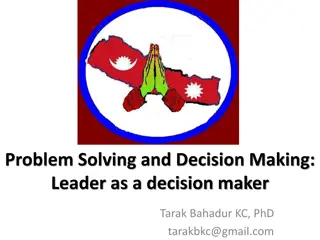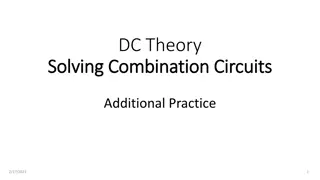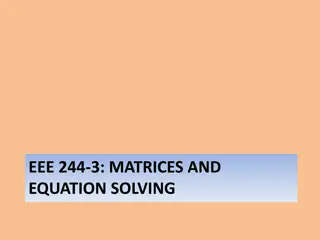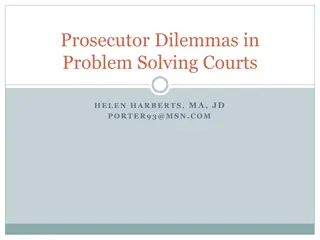Problem Solving December 2023
Officials in equestrian events have roles including ensuring the best interests of horses and athletes, promoting integrity and risk management, and fostering partnerships with competitors and organizers. Procedures for inquiries, protests, and appeals are also outlined, highlighting the importance of fair competition and open communication.
Download Presentation

Please find below an Image/Link to download the presentation.
The content on the website is provided AS IS for your information and personal use only. It may not be sold, licensed, or shared on other websites without obtaining consent from the author. Download presentation by click this link. If you encounter any issues during the download, it is possible that the publisher has removed the file from their server.
E N D
Presentation Transcript
Problem Solving December 2023 Marilyn Payne Gretchen Butts Wayne Quarles Tim Murray Cindy Deporter JM Durr
Officials Roles and Responsibilities We are responsible for the best interest of the Horse We are responsible for the best interest of the Athlete We are responsible for the actions of one another We must work to ensure high levels of risk management We must work to ensure high levels of integrity We must champion and congratulate equine welfare, good riding and Horsemanship in what ever form we see it Together we must be able to celebrate the thrill and challenge of our Sport
Creating a Partnership at the Event Officials must work together as a Team to assure that a fair, risk adverse, competition is run. Discussions throughout the competition should keep open lines of communication with competitors, organizers and fellow officials Working relationship means listening, addressing, investigating and addressing concerns raised by competitors, organizers and fellow officials Each official has a responsibility to listen to concerns that are shared and brought forward from riders
EV 115: Inquiries, Protests and Appeals 1. INQUIRIES. The Athlete, a parent or guardian of an Athlete under 18 years old, the owner of the Horse, or the owner s agent, may inquire about any perceived irregularity or scoring during the Event. Inquiries may be addressed to the Organizer, Ground Jury, or Technical Delegate. 2. PROTESTS: Protests must be in writing, signed, delivered to the event secretary, and accompanied by a fee made payable to the Organizer, which will be refunded if the protest (or subsequent appeal) is upheld.
3. TIME LIMITS FOR PROTESTS. Protests must be lodged within the following time limits: Protest Time Limit 1. Eligibility of a Horse or Athlete 1. Not later than one hour before the start of the relevant event 2. Not later than one hour before the start of the relevant phase 3. Not later than 6 pm the day before 4. Not later than 15 minutes before the start of the relevant phase 5. Not later than 30 minutes after the results of the relevant results are posted, Mathematical or transcription errors not later than 3 pm the day following the last day of the event. 2. 3. Condition of the Dressage arena Cross-Country Obstacle(s), course length, course condition, etc. Not later than 6 p.m. the day before Show Jumping Obstacle(s), course length, condition of arena, etc. Incidents during the Event or scoring (except errors as noted below) 4. 5.
EV 115: Inquiries, Protests and Appeals continued .. 4. APPEALS. An appeal against a ruling of the Ground Jury must be lodged within one hour of the announcement of the Ground Jury s determination. Appeals must be addressed to the Organizer, in writing, signed, and delivered to the event secretary. BOD 7/25/22 Effective 12/1/22
GR1037 Yellow Warning Card - Stewards and Technical Delegates 1. A Yellow Warning Card may be issued by a Steward, Technical Delegate, or Competition Official working in any of these capacities at the competition to any competitor, spectator or participant for improper conduct, or for noncompliance with the rules, provided the issuer considers the conduct not severe enough to cause the issuer to submit the matter to the Federation for a Disciplinary Action Complaint.
Reasons for Yellow Cards Important information to know about the issuance of a Yellow Warning Card: 1. A Yellow Warning Card must be issued to the alleged offender at the competition otherwise it is invalid 2. A Yellow Warning Card can be issued for minor offenses only and should not be used for abuse or major infractions of the rules. 3. A copy must be sent to the Federation with the Steward or Technical Delegate report 4. The Federation will contact the alleged offender so that they may respond to the card 5. The Federation may determine that a Charge or Administrative Penalty is warranted upon further review of the Warning Card 6. An individual who receives 3 Warning Cards within a 16 month period will be subject to a fine or Charge
Yellow Cards Issued in 2023 EV128.4 Rider continued and completed cross country after a compulsory retirement Loose dog at competition in the stable area GR1301.6 Trainer rode student's horse in the warm up after 3 pm the day before the event. Trainer knew of the rule but thought the time cut off was 6pm Rider was eliminated at fence 13. Fence judge told rider to leave, directions were ignored and rider jumped subsequent jump Loose dog on cross country course EV111.1 EV 121.10 GR1301.6 GR1301.6 Competitor was driving around the cross country with her dog running loose On multiple occasions dog were seen off leash and wondering the show grounds. The dogs approached other dogs on leash and wandered to other stalls and campers. GR1301.6 Dog was seen loose, off leash chasing farm owners cat behind office. Dog then went after the farm owner behind the knee and hand. Owner told to leave dog in trailer. Dog was seen outside again after incident. GR1301.6 On multiple occasions dog were seen off leash and wondering the show grounds. The dogs approached other dogs on leash and wandered to other stalls and campers. GR1301.6 Horse was galloping out of control on cross country; jumped out of the roped off lane, then rider turned around and jumped back in and continued EV113.2 Rider was eliminated for 3 refusals. Left the ingate/out gate at a gallop, jumped a warm- up fence and then galloped circles with the horse. Rider was then rude to the TD when approached about the dangerous riding. Rider loudly proclaimed it was people like the TD who were ruining the sport. EV113
Dangerous Ridings Given in 2023 Total of 8 Dangerous Riding given in 2023 -2 at Intermediate -1 at CCI 2star -2 at Preliminary -1 at Novice -2 at Beginner Novice 4 of these DR s were eliminations 1 involved a rider fall,the remainder were given 25 penalty points
Watch List The USEF Eventing Watch List ("Watch List ) is comprised of USEF and/or USEA members competing in the U.S. who have been identified as displaying potentially dangerous or unsafe riding (see definitions below) during warm-up or any phase at a USEF Eventing Licensed Competition, received an FEI Eventing Recorded Warning or Yellow Card for Dangerous Riding at any FEI event, been penalized at a national competition for Dangerous Riding, or received a Yellow Warning card for Dangerous Riding at a national competition. The goal of the Watch List is to improve rider safety and provide Licensed Officials (Technical Delegates and Ground Jury) the opportunity to observe athletes at future events.
The following are designated Watch List reporters: USEF Eventing Technical Delegate, Judge, or Course Designer; U.S. FEI Eventing Steward, Technical Delegate, Judge, or Course Designer U.S. Eventing National Safety Officer; Athletes who have represented the United States in Eventing at a World Championship, Olympic Games, or Pan American Games; and Instructors who currently hold a Level IV or V USEA ECP certification.
Competition Licensed Officials Responsibilities Upon being notified by a Reporter of an instance of dangerous or unsafe riding, when possible, the Competition Licensed Official should watch the athlete s subsequent rounds of competition. The Competition Licensed Official must enforce relevant safety rules, including the issuance of a Yellow Card. It is not the duty of the Licensed Official to make training recommendations to the athlete. Doing so is outside the scope of the Licensed Official s duties. If notified of an instance of dangerous or unsafe riding by a Reporter, the Technical Delegate must include in their Technical Delegate Report: Reporter s name, any additional eyewitnesses and their statements, any observations made in observing the athlete, and attempts made to contact the athlete.
Filing a Watch List Report When a Reporter witnesses an incident that warrants an athlete being placed on the Watch List, the Reporter must submit the Watch List Report Form to USEFEVENTING@USEF.ORG. Reporters are encouraged to make their reports to USEF as soon as possible. Athlete Notification: When added to the Watch List, athletes will receive written details regarding the specifics of the Watch List Program and the circumstances warranting the addition of the athlete to the Watch List
Specifications for the Watch List In addition to reports received as described above, U.S. athletes who have received an FEI Eventing Recorded Warning or Yellow Card for Dangerous Riding at any FEI event, been penalized at a national competition for Dangerous Riding, or received a Yellow Warning card for Dangerous Riding at a national competition will be placed on the Watch List. An athlete who loses qualification at any level two times in a 12- month period, will be placed on the Watch List. 1.An athlete will remain on the Watch List for 12 months from the initial report date. 2.In the event an athlete receives a subsequent report while on the Watch List, the athlete will be contacted again by the USEF Eventing Department as described above and may be referred to USEF s Regulation Department and be subject to the penalties set forth in Chapter 7 of the USEF Rulebook. The 12-month period will restart. 3.Should an athlete receive three reports, at separate events, the athlete may be referred to USEF s Regulation Department and may be subject to the penalties set forth in Chapter 7 of the USEF Rulebook.
Other Information Removal from the Watch List: An athlete will be removed from the Watch List following a 12-month period without further reports, incidents, or loss of qualification(s). Distributing and Monitoring of the of the Watch List: The Watch List can be viewed by current USEF Licensed Officials through the Licensed Officials Dashboard on usef.org. Athletes who have been placed on the Watch List can view their status on their Athlete Dashboard. The USEF Technical Delegate must check the Watch List prior to each competition for which they officiate. If you have any questions regarding the Eventing Watch List, please contact Director of Eventing Sport Administration, Alison Lloyd at alloyd@usef.org or 859-225-2054.
Definitions: USEF and FEI EV113.1 Dangerous Riding is defined as instances when an athlete rides in such a way as to constitute a hazard to the safety or well-being of themselves, their horse, and/or other persons or horses. FEI Eventing Article 525.1 - Dangerous Riding Definition Any Athletes who, at any time during the Competition deliberately or unintentionally by incompetence are exposing themselves, their Horse or any third party to a higher risk than what is strictly inherent to the nature of the Competition will be considered to have acted dangerously and will be penalized accordingly to the severity of the infringement.
Such acts include without limitation: 1. Riding out of control (Horse clearly not responding to the Athletes restraining or driving aids). 2. Riding fences too fast or too slow. 3. Repeatedly standing off fences too far (pushing the Horse to the foot of the fence, firing the Horse to the fence). 4. Repeatedly being ahead or behind the Horse movement when jumping. 5. Series of dangerous jumps. 6. Severe lack of responsiveness from the Horse or the Athlete. 7. Continuing after three clear refusals, a fall, or any form of elimination. 8. Endangering the public in any way (e.g. jumping out of the roped track). 9. Jumping obstacles not part of the course. 10. Willful obstruction of an overtaking Athlete and/or not following the instructions of the Officials causing danger to another Athlete. 11. Pressing a tired Horse.
























